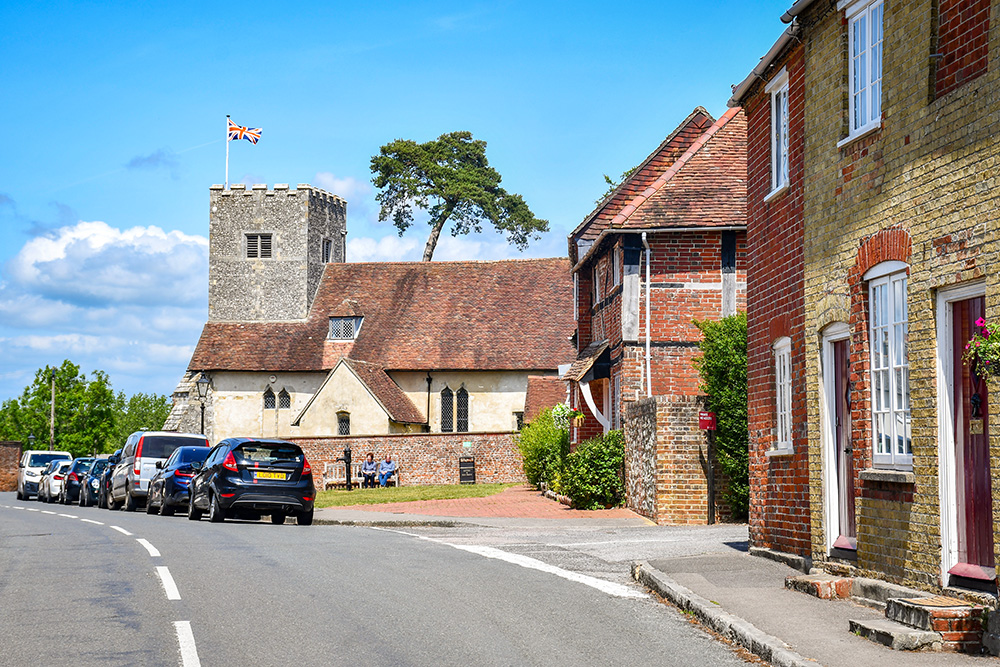Nestled beneath the northern slope of Portsdown Hill, at the southern end of the Meon Valley, Southwick looks like something straight out of a picture postcard: half-timbered cottages, thatched roofs, pubs with dark beams, flowers tumbling from window boxes… and one intriguing detail – every single front door is painted red.
This isn’t a whimsical neighbourhood fashion statement.
It’s a rule written into a legal covenant, imposed by the Thistlethwayte family, who have owned the estate for nearly five centuries.
For a village so small, Southwick has an extraordinary claim to fame: in 1944, it became the nerve centre of Operation Overlord, the Allied invasion of Normandy that changed the course of the war – and the future of France and Europe.
That connection to Normandy makes it a particularly fascinating place to feature here, on a blog devoted to France’s history and culture.
It also happens to be practically on my doorstep – less than ten minutes from home – so I’ve had the pleasure of wandering its streets several times, taking in both its timeless charm and its remarkable history.
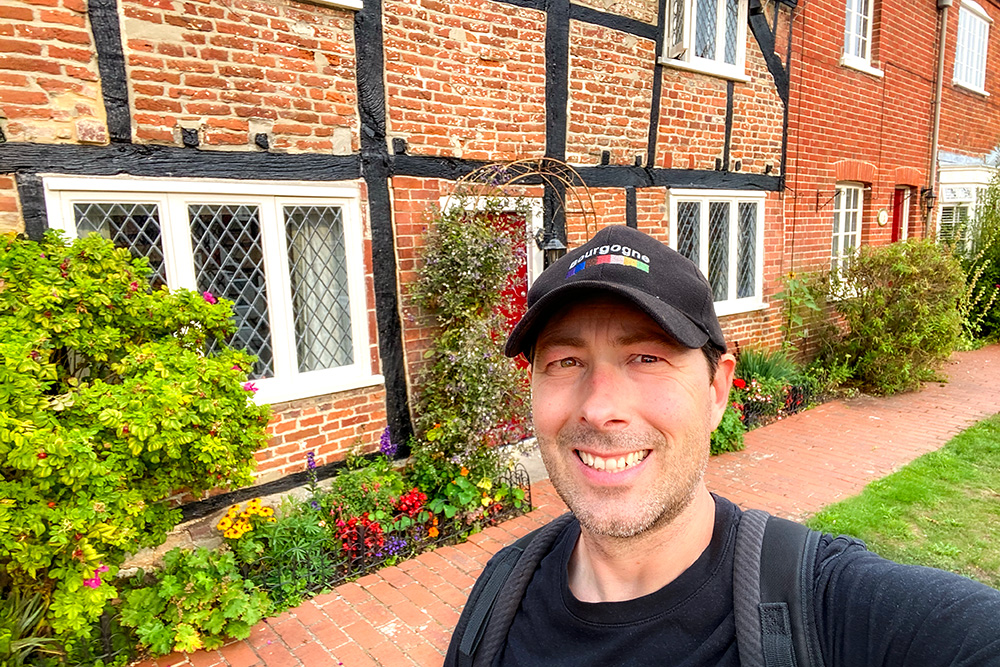
Me at Southwick!
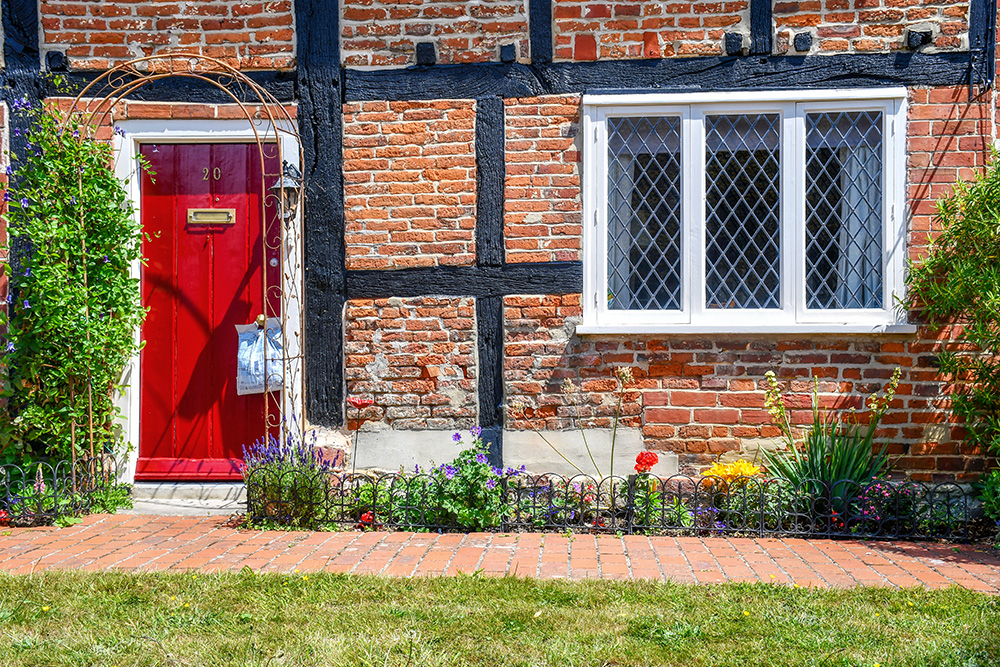
Cottage in the village of Southwick, Hampshire. All photos © French Moments, unless otherwise noted.
Southwick: A Little History
From Prehistory to the Romans
The story of Southwick begins long before monks and manor houses.
Archaeological digs on Portsdown Hill have uncovered flint tools and a Neolithic long barrow containing twelve skeletons – one with an arrowhead embedded in its skull.
The Bronze Age (2000–1000 BC) and Iron Age (1000 BC–the start of our era) have also left their marks here.
In AD 43, the Roman legions advanced through this area, building Route 421 from Chichester to Winchester, with a staging post at Southwick and a link to their fort at Portchester.
A thousand years later, the Normans would probably have marched along the very same road during their conquest.
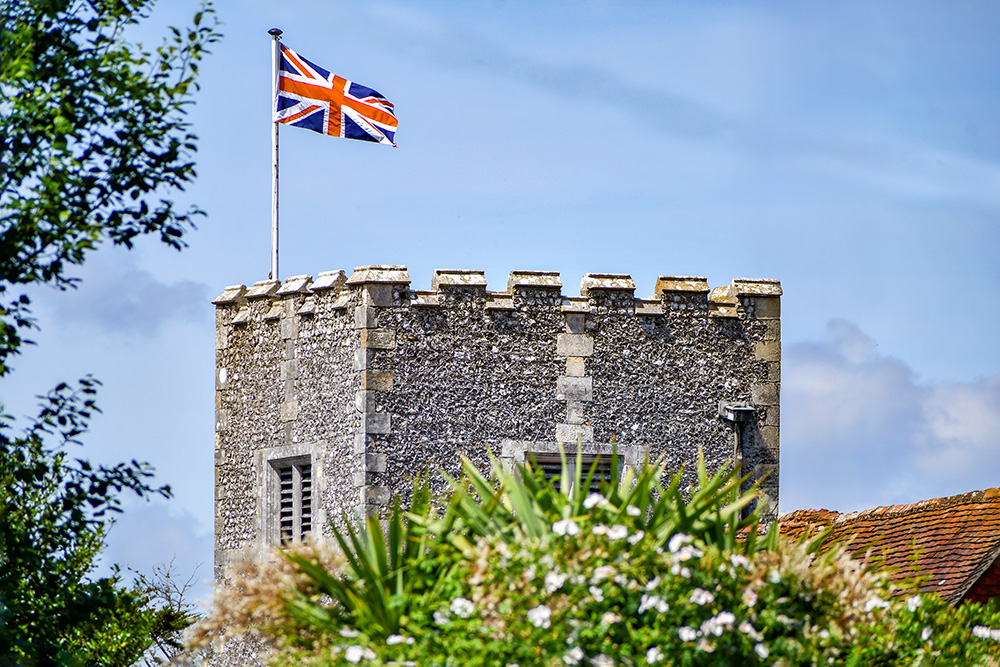
Church of Southwick
The Medieval Priory: 400 Years of Spiritual Life
Around 1128, Augustinian canons established themselves at Portchester Castle.
Finding the location impractical, they moved around 1150 to found Southwick Priory – a self-sufficient world with a square cloister, church, refectory, orchards, fishpond, and dovecote, living by the rhythm of worship and agricultural work.
The Marian shrine of Our Lady of Southwick drew pilgrims and kings – even Henry VIII, who visited before closing it in 1538.
The monastic buildings were turned into a manor house, but one precious fragment remains: the north wall of the refectory, dating from the 1180s, with its Romanesque columns and the site of the sculpted laver depicting the Heavenly Jerusalem (now preserved at Fort Brockhurst).
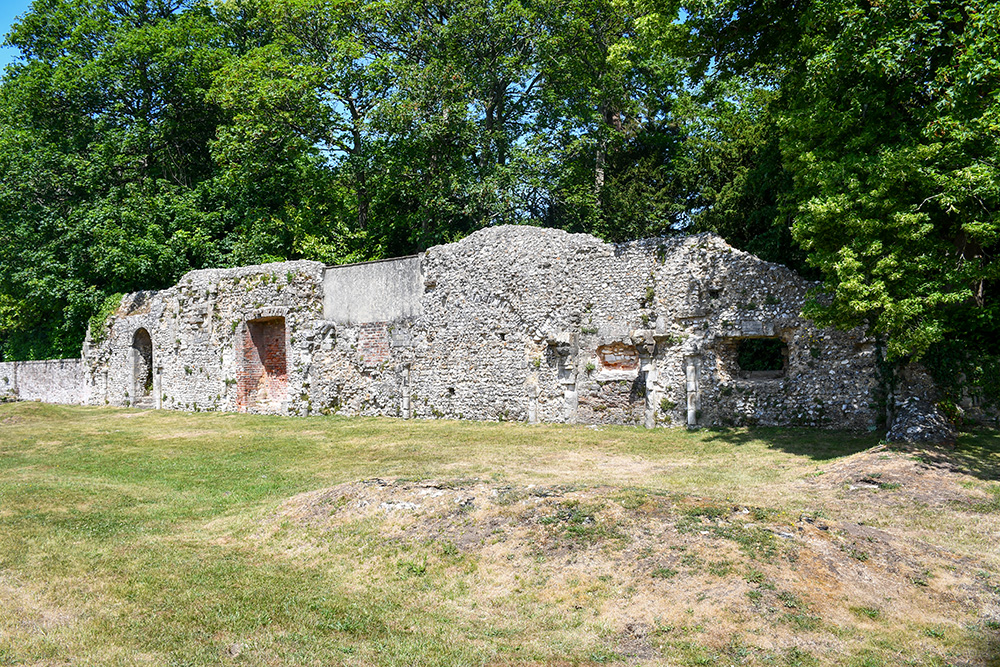
The remains of Southwick Priory
From the 17th Century to the Victorian Fortifications
In the early 17th century, Daniel Norton built a residence on the priory site.
King Charles I visited him here, but in a twist of history, Norton’s son – “Idle Dick” – would go on to sign the king’s death warrant during the Civil War.
In 1862, fearing a French invasion, the government purchased 900 acres on Portsdown Hill to build a chain of defensive forts (Nelson, Purbrook, Southwick, Widley).
Nicknamed “Palmerston’s Follies”, they never fired a shot in anger.
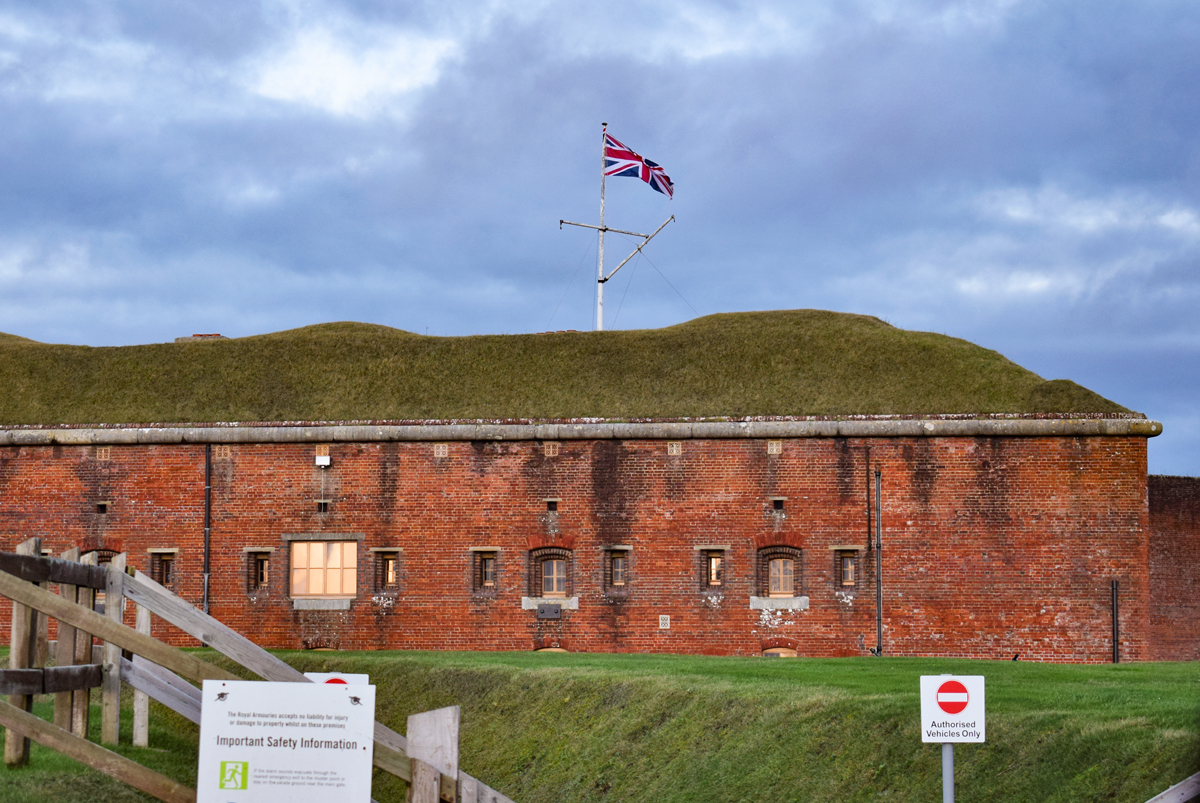
Fort Nelson is part of the Portsdown Hill fortifications.
1944: D-Day Headquarters
In 1941, in the midst of the Second World War, the Royal Navy requisitioned Southwick House, an elegant 19th-century Georgian mansion overlooking Portsdown Hill.
Its plush rooms, wide windows and panelled drawing rooms would soon echo not with the polite conversation of the Squire, but with the clipped orders of military officers and the rustle of unfolded maps.
Three years later, in the early summer of 1944, the house became the nerve centre of one of the most daring military operations in history.
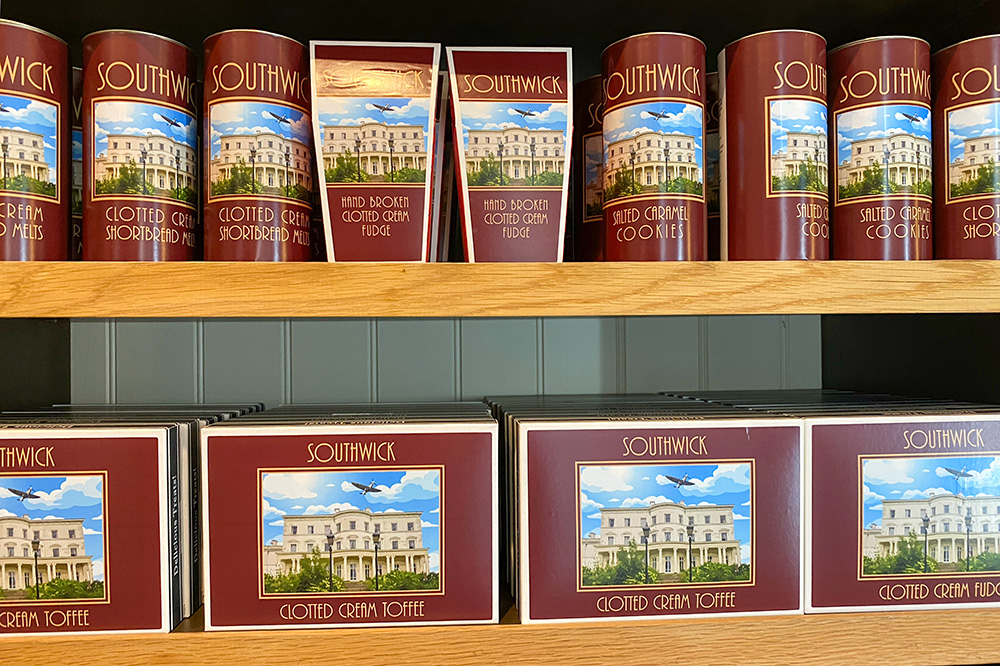
Fudges in honour to Southwick House
It was here, in the former library – transformed into a war room – that General Dwight D. Eisenhower, Supreme Commander of the Allied Expeditionary Force, took the irreversible decision to launch Operation Overlord.
Three million men, 2,727 ships, thousands of aircraft… and, at the end of this vast undertaking, the hope of liberating occupied Europe.
The famous D-Day wall map, still in place today, was used to track the movement of troops and ships in real time.
Every piece moved on that map represented hundreds of human lives – and a fragment of the war’s outcome.

While visiting Southwick, I had the opportunity to get in an American jeep!
Southwick during the Second World War
Meanwhile, the village itself lived to the rhythm of the mission.
The Golden Lion, a Tudor pub at the heart of Southwick, served as an officers’ mess.
Its wooden floorboards creaked under the boots of senior ranks, and its dark-beamed walls were witness to conversations where gravity sometimes gave way to camaraderie.
It’s said that in the mornings, Eisenhower would come in for a half-pint of bitter, while Montgomery – a staunch teetotaller – stuck to grapefruit juice.
They would settle into a corner to the left of the fireplace, sometimes simply to talk, sometimes to spread maps and documents across a small table, away from the bustle of Southwick House.
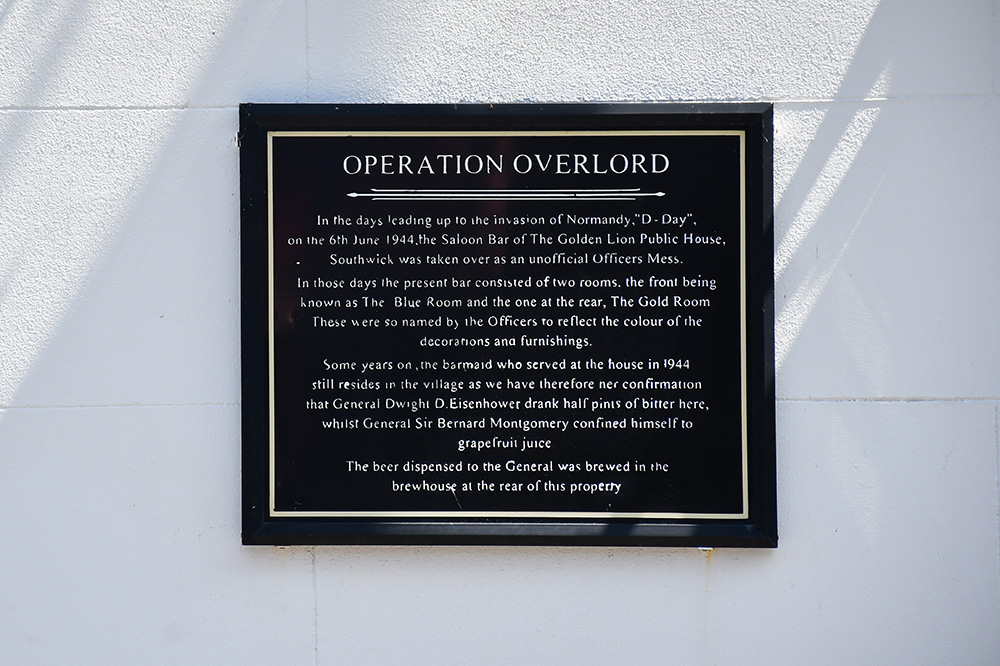
A commemorative plaque on the wall of The Golden Lion pub details the visits of Eisenhower and Montgomery.
One likes to imagine that, in the hushed calm of that ancient, timbered room, the final refinements to the D-Day plan took shape.
Today, the Golden Lion has preserved that atmosphere.
Patrons sip their pints knowing that, here, on a June morning in 1944, the largest amphibious operation in history was being prepared.
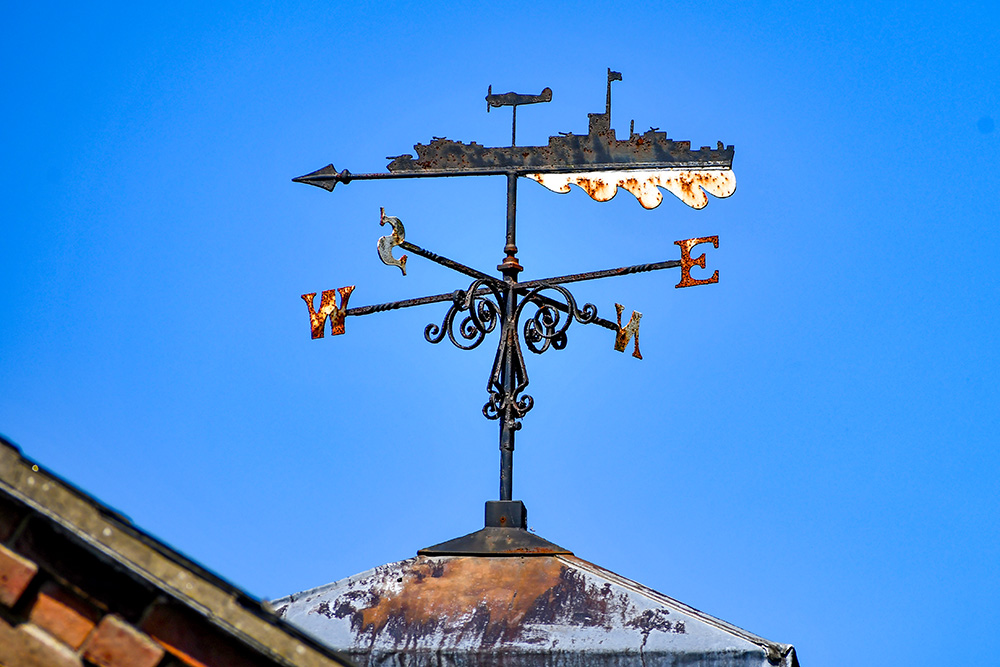
The Village Hall weathervane depicting a ship and a plane during the Normandy landings
Southwick Today: What to See
Here are some interesting places to discover in the village.
The Priory Refectory Wall
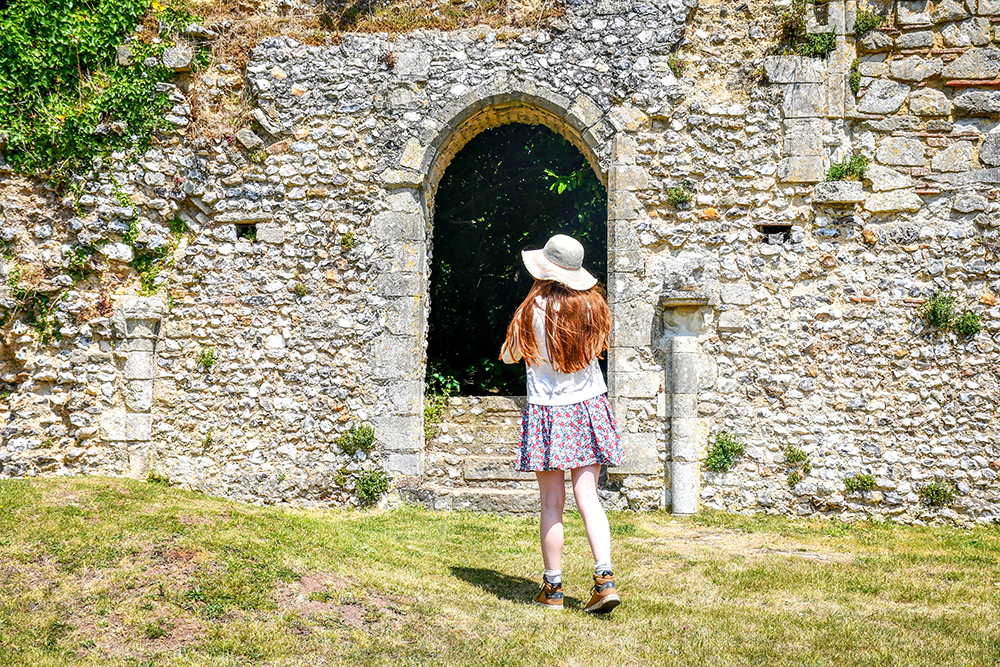
Southwick Priory
It may look modest, and yet… this stretch of stone, now standing alone in the grass, is the only visible remnant of the Augustinian Priory of Southwick, founded in the 12th century.
It once formed the north wall of the canons’ refectory, where you could once make out the vaulted ceilings and the staircase leading up to the dining hall above.
Imagine the monks walking in procession, pausing to wash their hands in a carved laver before taking their seats, the silence broken only by the voice of the reader reciting scripture.
The ruins can be accessed via a small path through the woods starting from Priory Road (the road leading to Southwick House).

On the path leading to the ruins of the priory
St James Without the Priory Gate
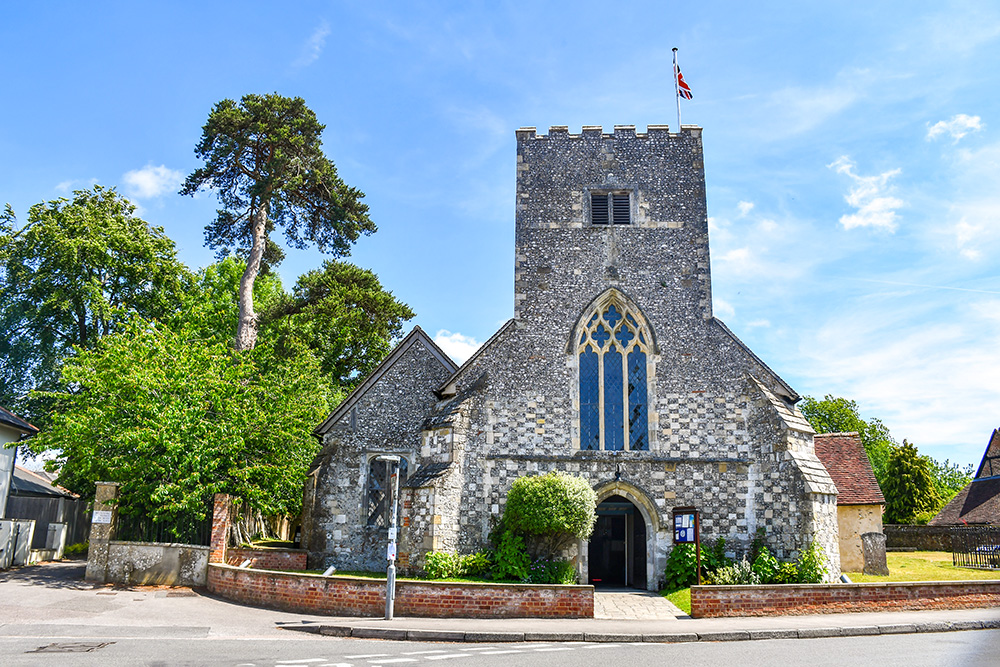
Southwick Church
In the heart of the village stands a church with a distinctive name: St James Without the Priory Gate.
As the name suggests, it was built outside the medieval priory walls.
What makes it truly unique is its status as a Peculiar: it lies outside the jurisdiction of the diocesan bishop and is instead directly under the authority of the estate’s owner – the well-known “Squire”.
Inside, there’s a rare Elizabethan altar – a striking survivor of the religious upheavals of the 16th century.
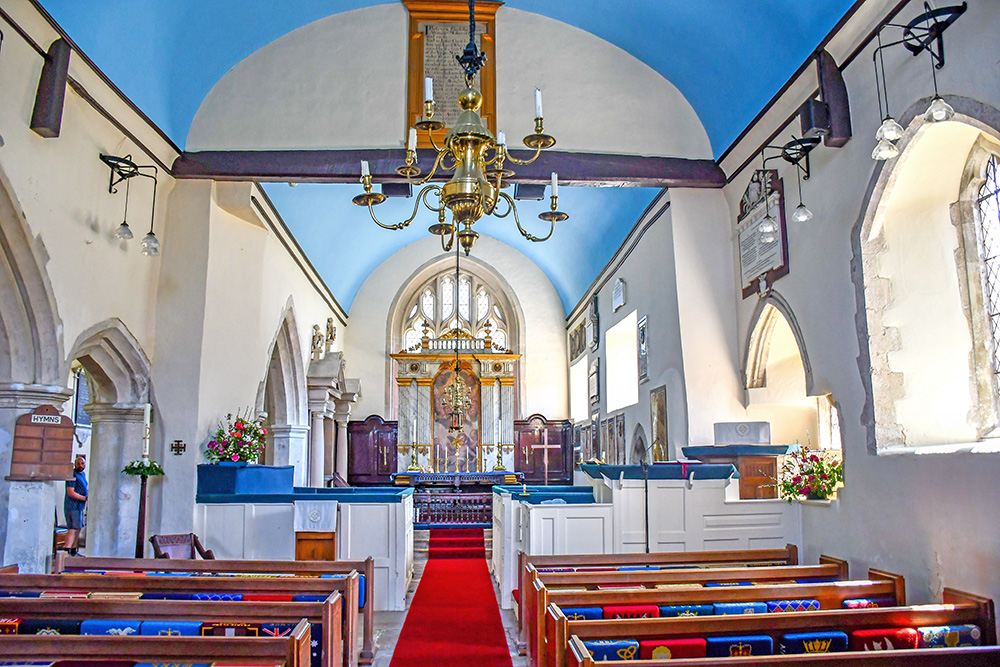
Inside the church
Golden Lion & Red Lion
Two historic pubs that each capture something of the village’s soul.
- The Golden Lion: A Tudor building with its charm intact, it served as an officers’ mess during the D-Day preparations. Eisenhower would drink his half-pints of bitter here, Montgomery his grapefruit juice. It’s said they would spread maps and documents on a small table just to the left of the fireplace. Today, the pub retains that atmosphere, with its dark beams and walls lined with memorabilia.
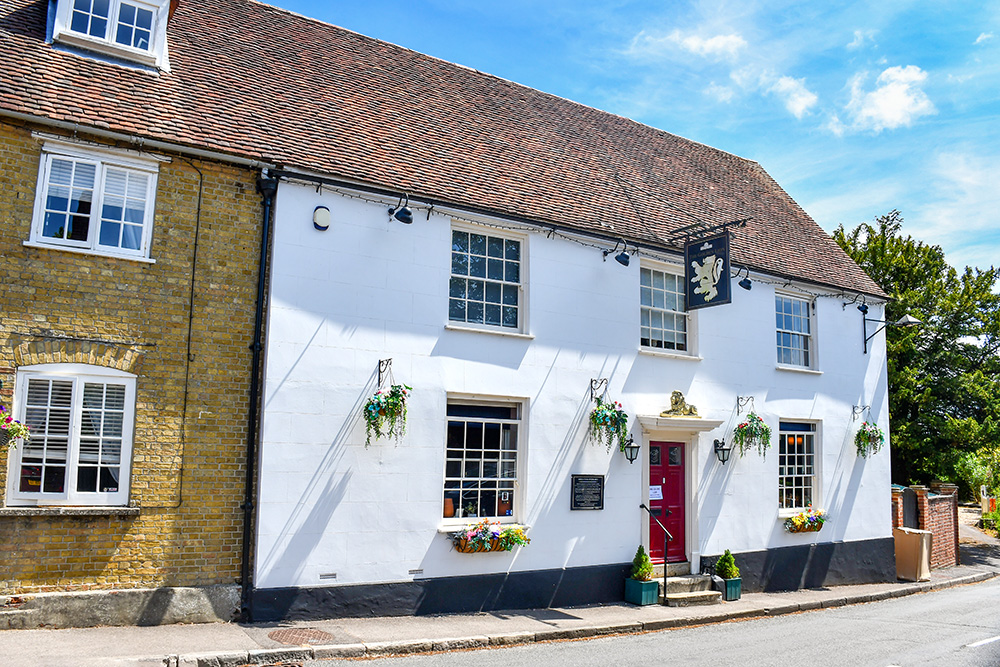
The Golden Lion in Southwick
- The Red Lion: Located on the High Street, it had, until the 1980s, the unusual rule of serving only beer and cider – a decision made by the Squire of the time, keen to ensure the sobriety of his agricultural workers. During the war, it was run by Horace “Hoppy” Crook, whose brother farmed the land opposite.
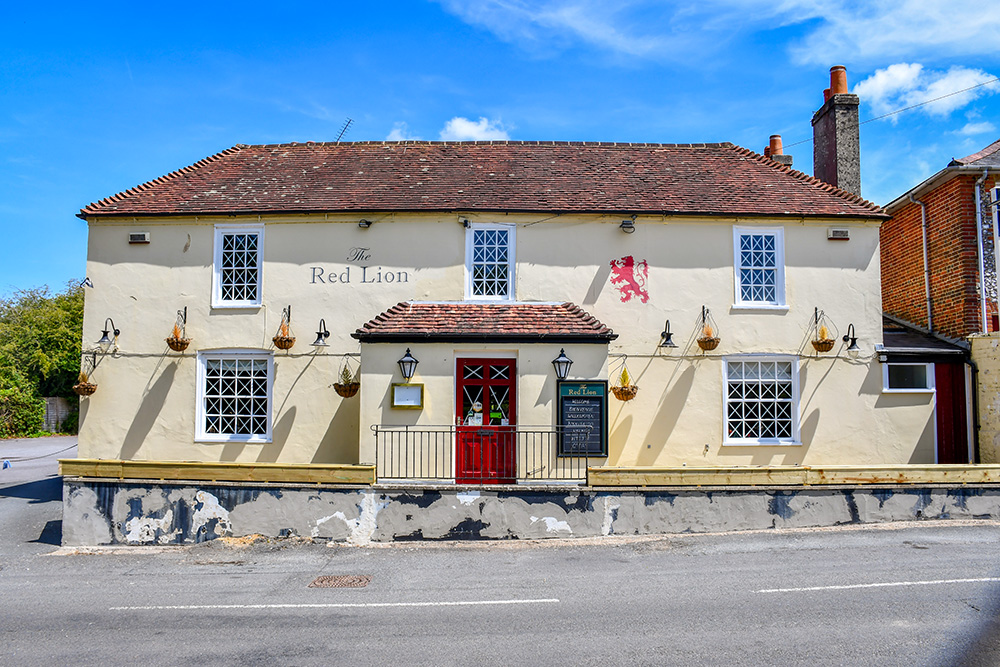
The Red Lion in Southwick
Southwick’s Thatched Cottages
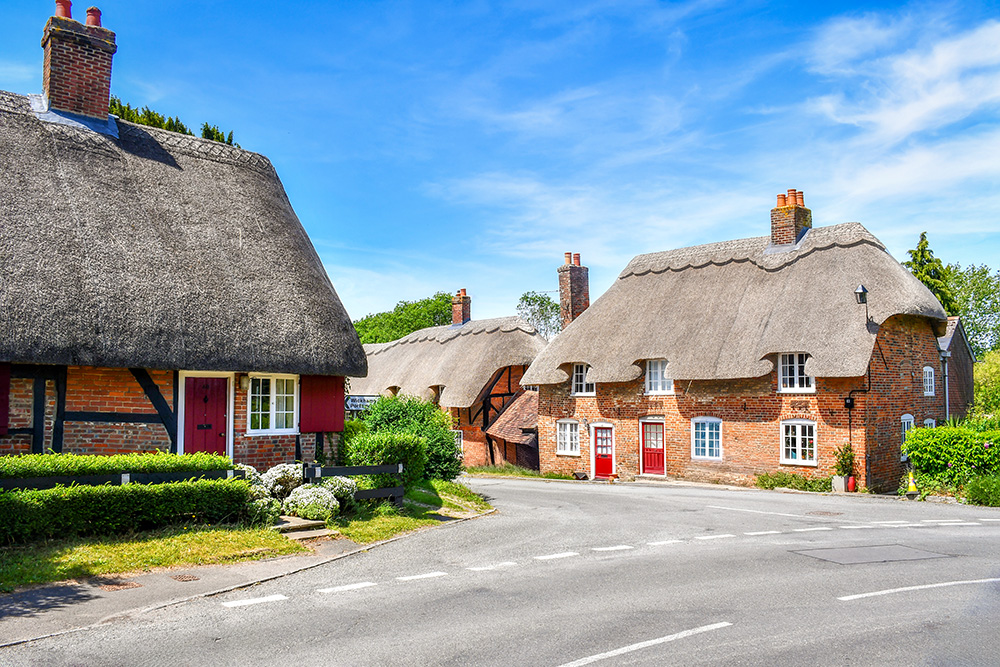
Cottages in Southwick
Southwick may be a small village, but it offers a delightful showcase of traditional English rural architecture.
Strolling along the High Street and its side lanes, you’ll come across numerous well-kept old houses with thatched roofs, some of which still display beautiful exposed timber framing.
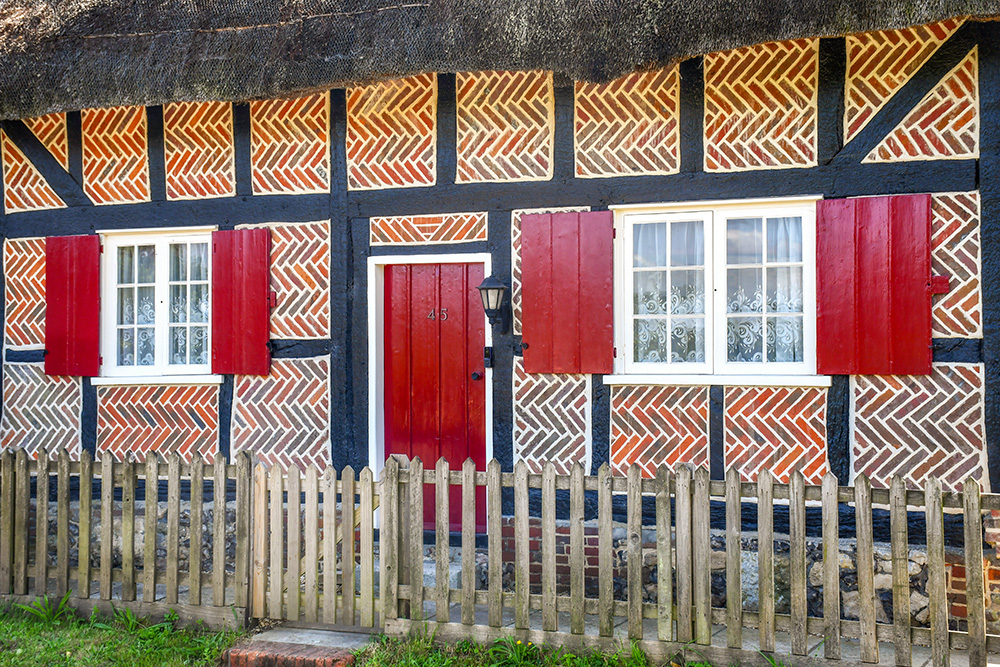
Red dominates in Southwick!
These cottages, often with low ceilings, line up their brick walls – some whitewashed – and their small leaded windows.
In summer, their façades are adorned with hollyhocks, wisteria, or climbing ivy, adding a bucolic charm to the scene.
Each house tells its own story, whether it began life as a farmhouse, a worker’s cottage, or a more substantial home once belonging to someone connected with the estate.
Their variety and excellent state of preservation are a major part of Southwick’s timeless appeal, inviting you to linger and admire them – camera in hand.
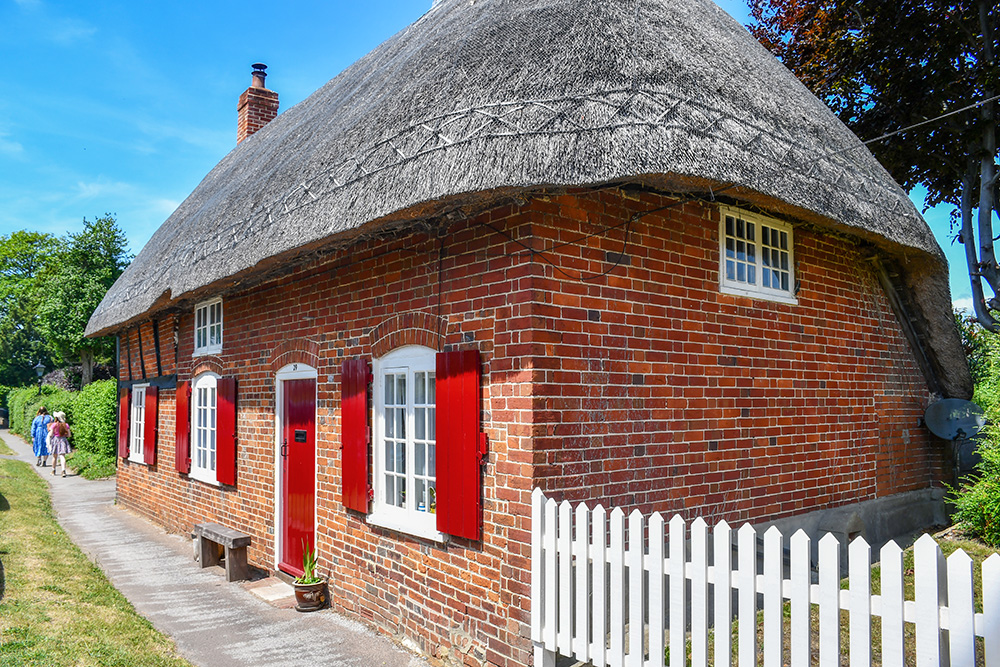
A pretty cottage in the centre of the village
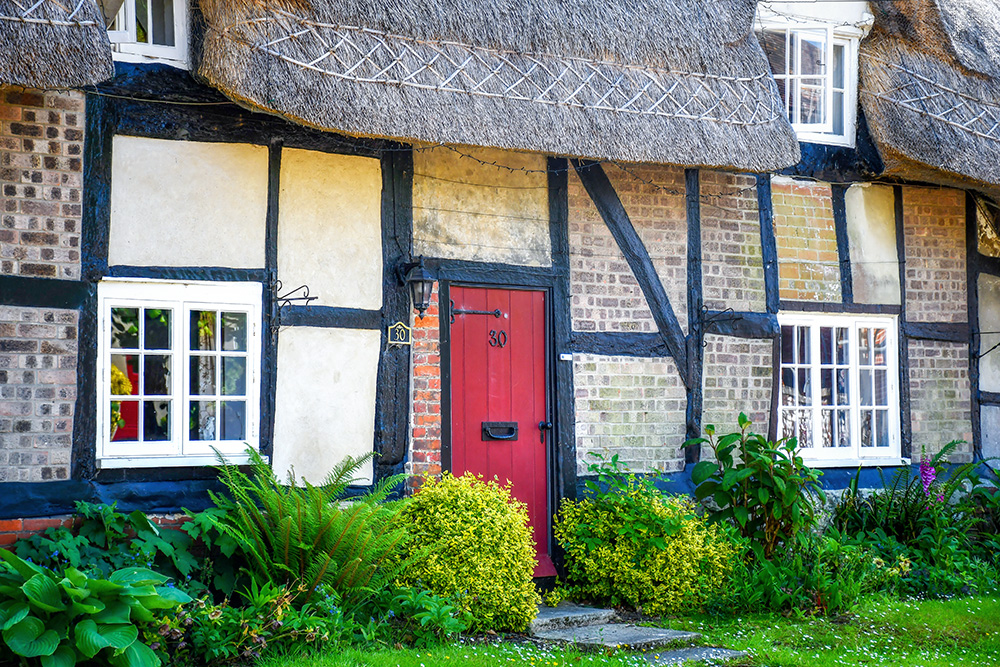
Another cottage in the village (West Street)
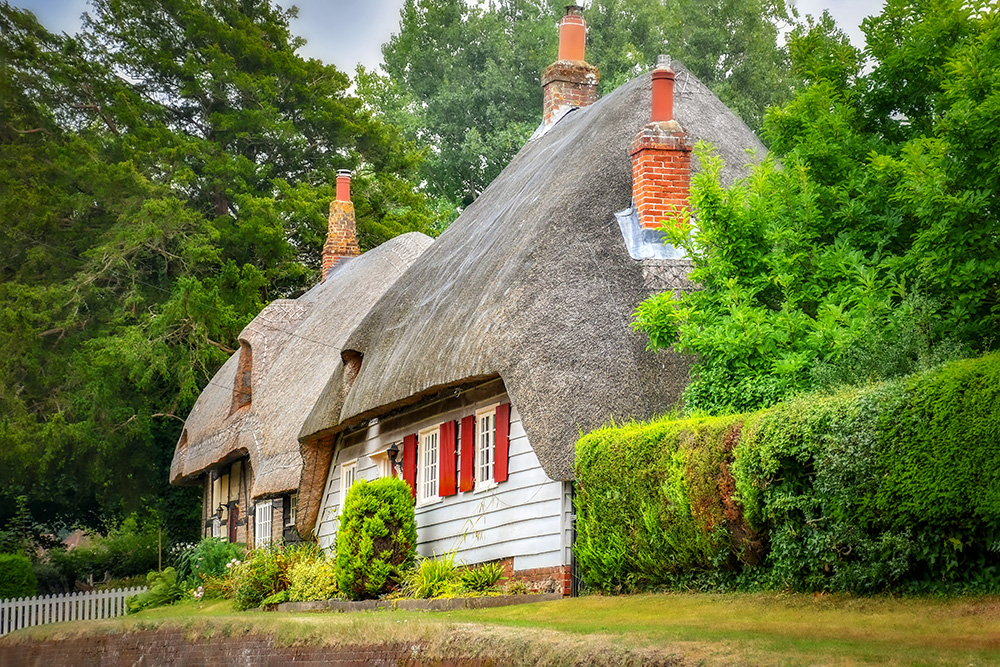
Double cottages!
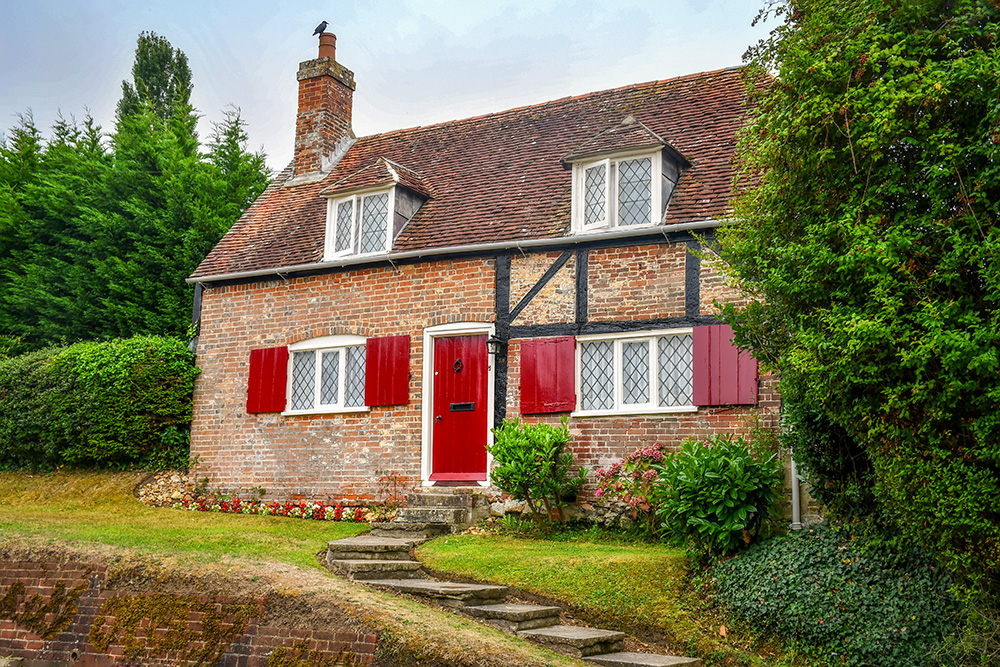
An old cottage in Southwick
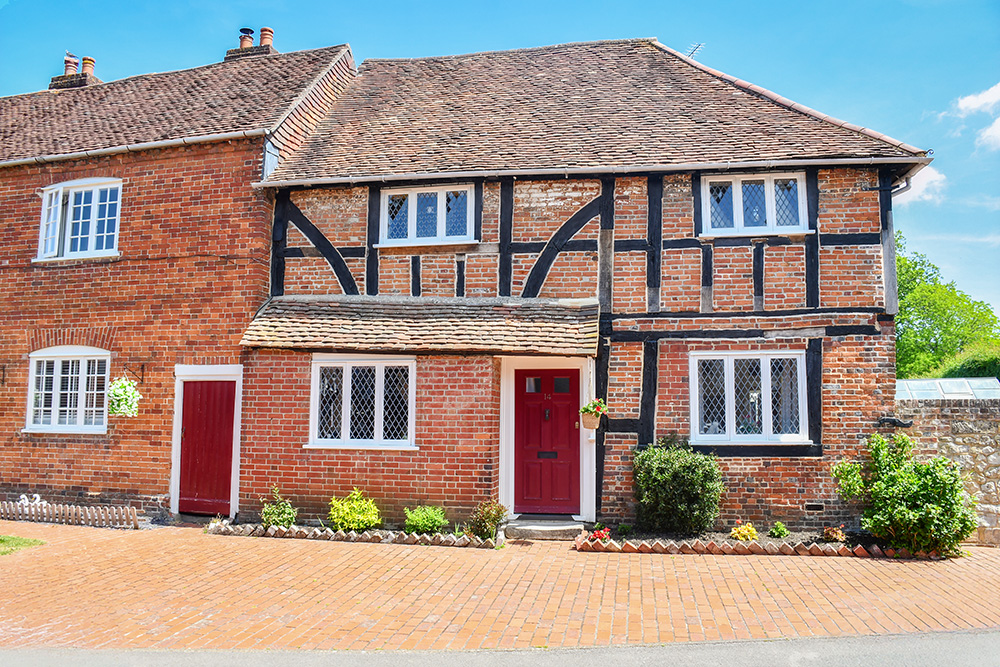
Old houses in Southwick
Southwick's Famous Red Doors
As mentioned before, in Southwick, all the houses in the old village – those belonging to the estate – have doors painted in the same vivid red.
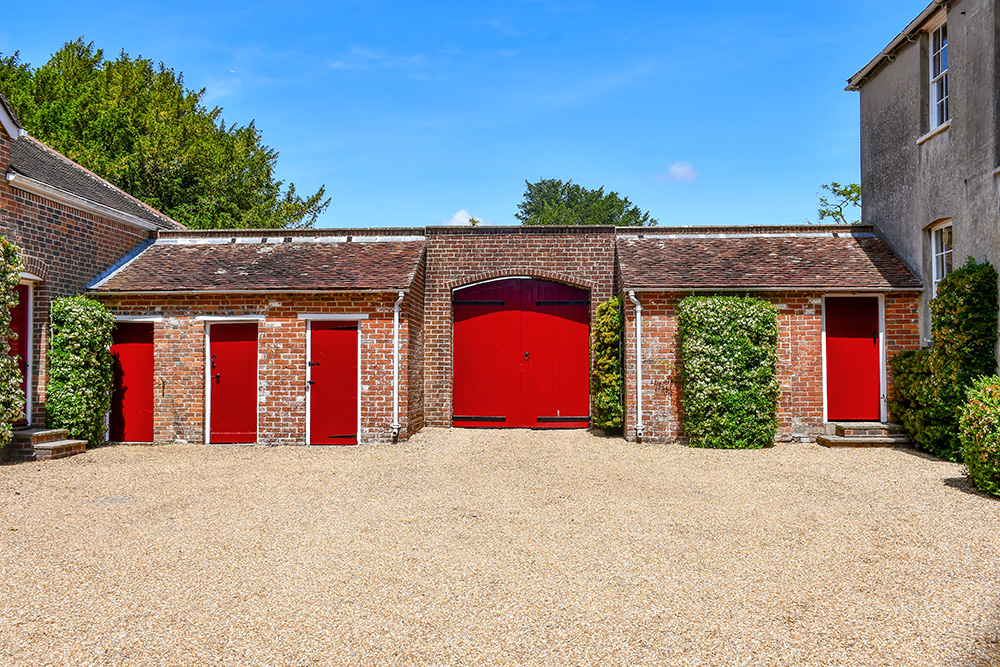
The red doors of Southwick
This isn’t a coincidence, but a rule set out in a covenant by the Thistlethwayte family, owners of the village for nearly five centuries.
Tradition says the colour was chosen by an ancestor simply because it matched his favourite motor car.
The rule has remained unchanged ever since, becoming one of the village’s signature features.

A pretty cottage with a red door
There are, however, only two exceptions: the White House, residence of the vicar, and Church Lodge, the only privately-owned house in the old village.

Church Lodge is the only privately-owned house in the old village
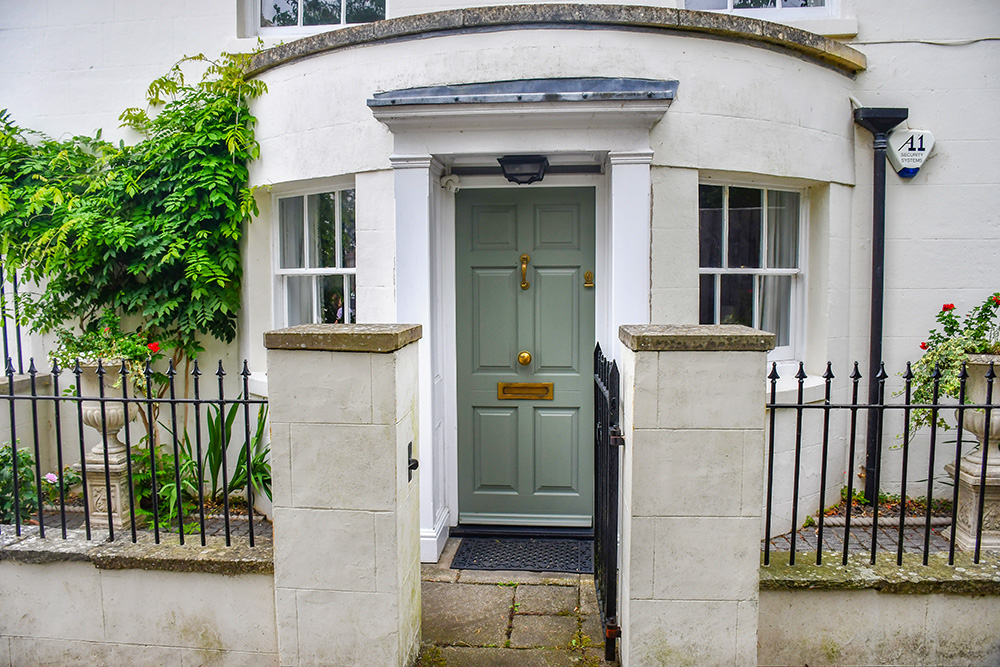
Church Lodge does not have a red door!
Their doors are painted white – a detail that sharp-eyed visitors often notice, and a reminder that even in a place of strong traditions, there are always a few exceptions.
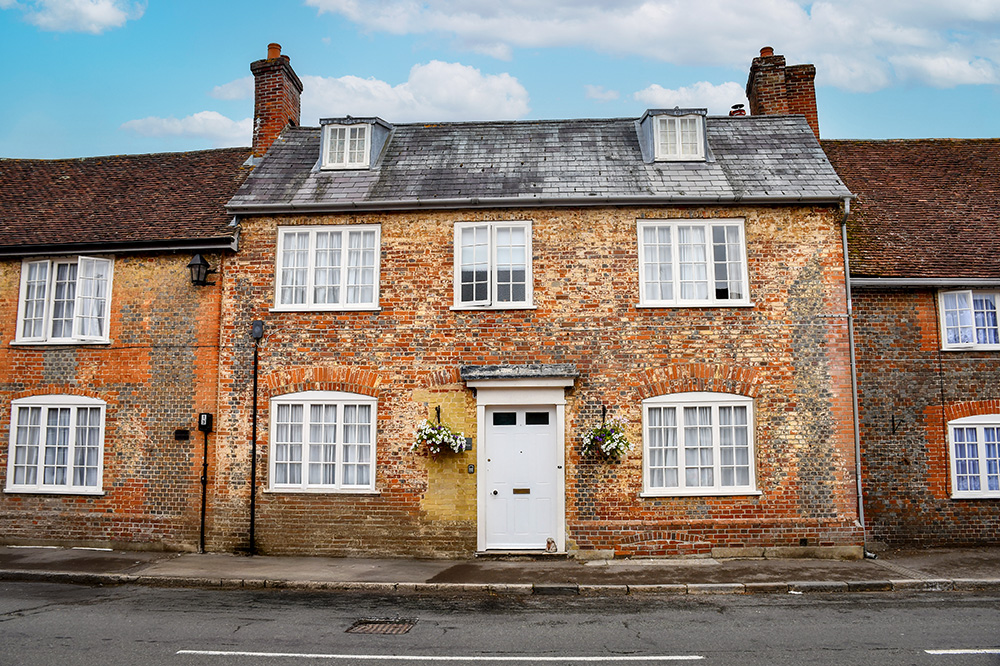
Southwick's White House and its white door
Southwick Brewhouse
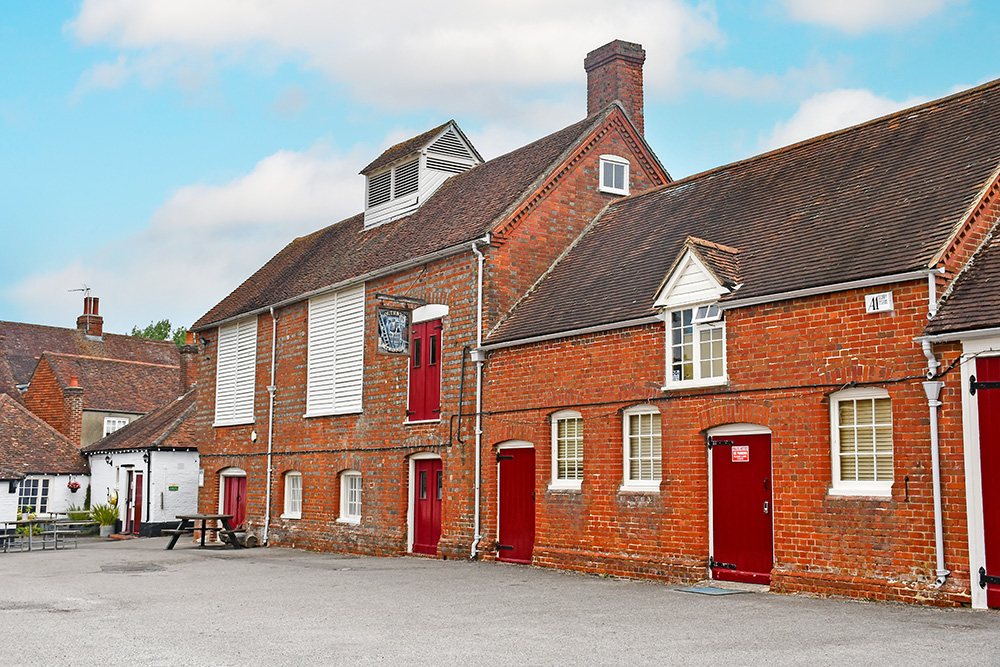
Southwick Brewhouse
Just behind the Golden Lion, the Southwick Brewhouse is a small industrial gem: a Victorian steam brewery, a scheduled ancient monument, complete with all its original equipment.
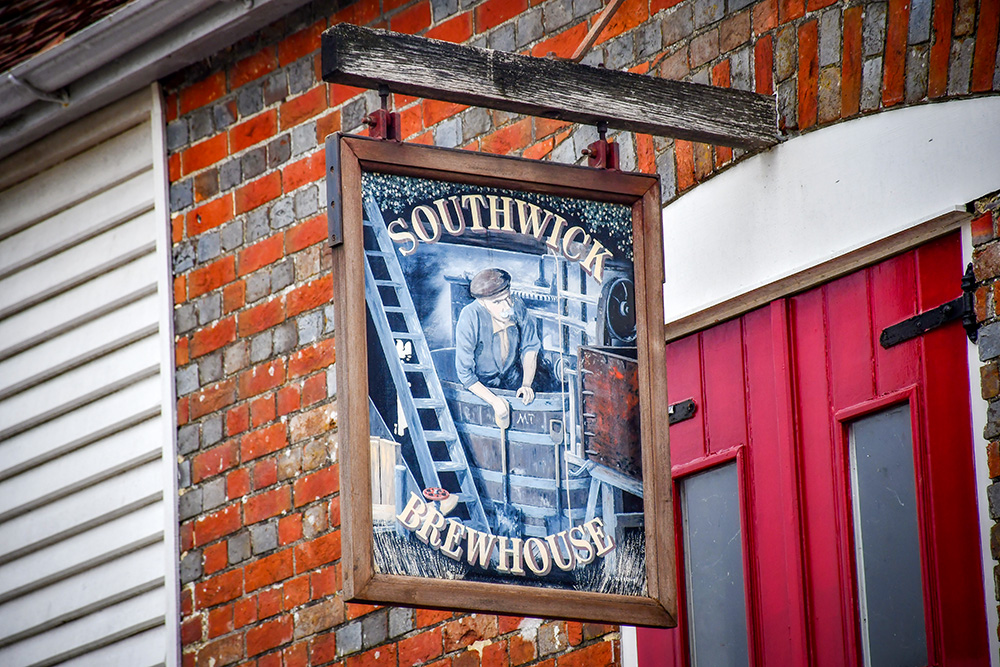
Southwick Brewhouse
Built to supply beer to the pub, it’s now open as a museum and shop, where you can buy craft beers and souvenirs.
A must for anyone who loves heritage… and a good pint.
Southwick Stores & Tea Rooms
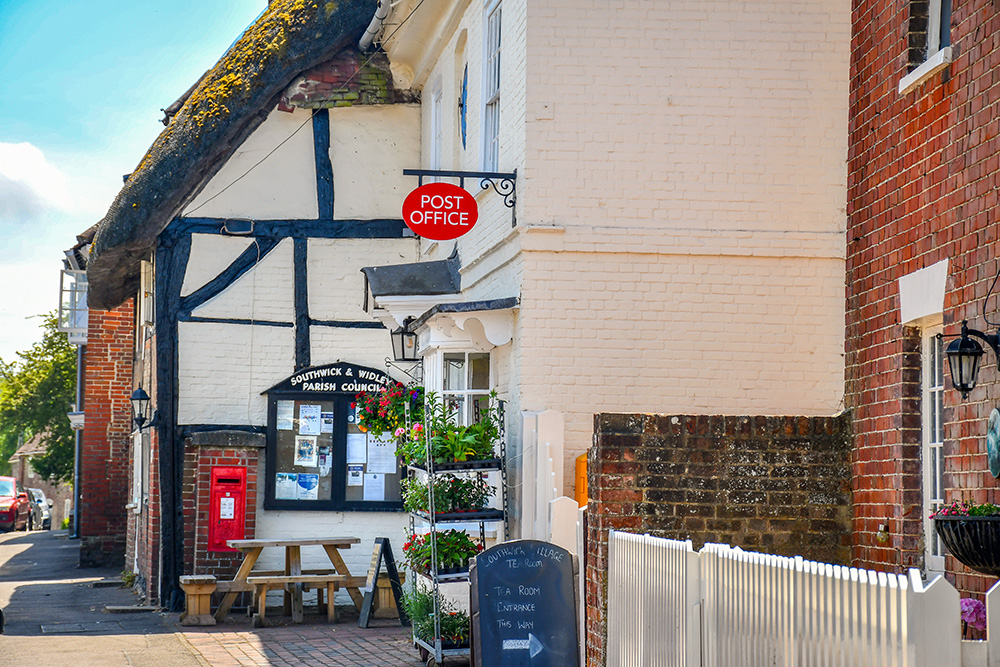
The store and tea-rooms
Renovated in 2017, the shop and tea rooms have become a genuine hub for village life.
Here you’ll find fresh local produce, groceries, and a cosy space to enjoy a coffee, a light lunch, or a slice of homemade cake.
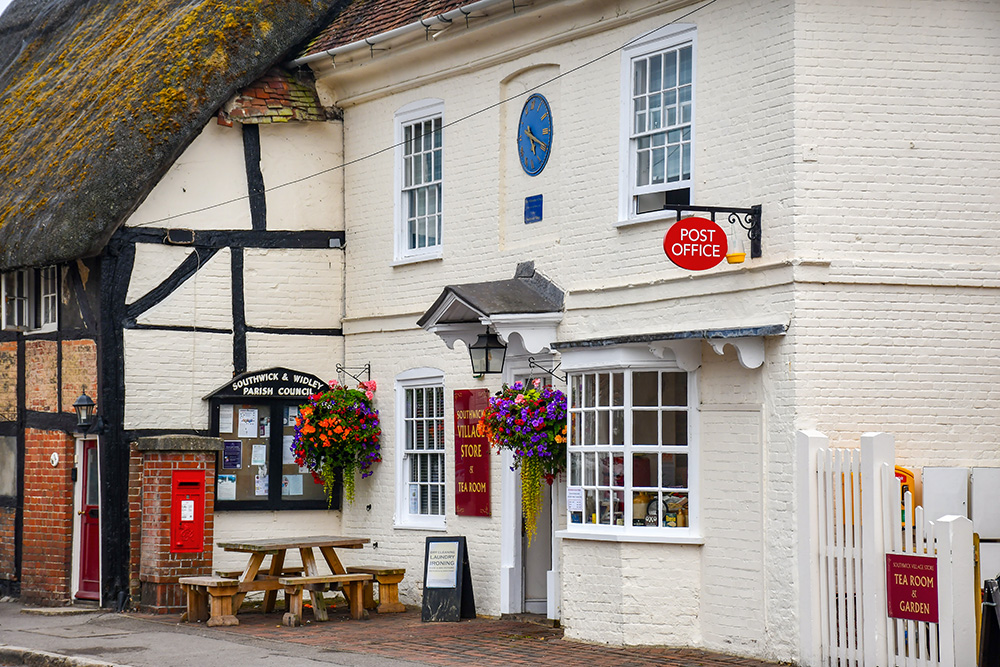
The Stores and post-office
One wall is entirely taken up by a remarkable mural, painted by local artist Megan Attwell, depicting the Liberation of Europe.
A tasty stop with a touch of history.
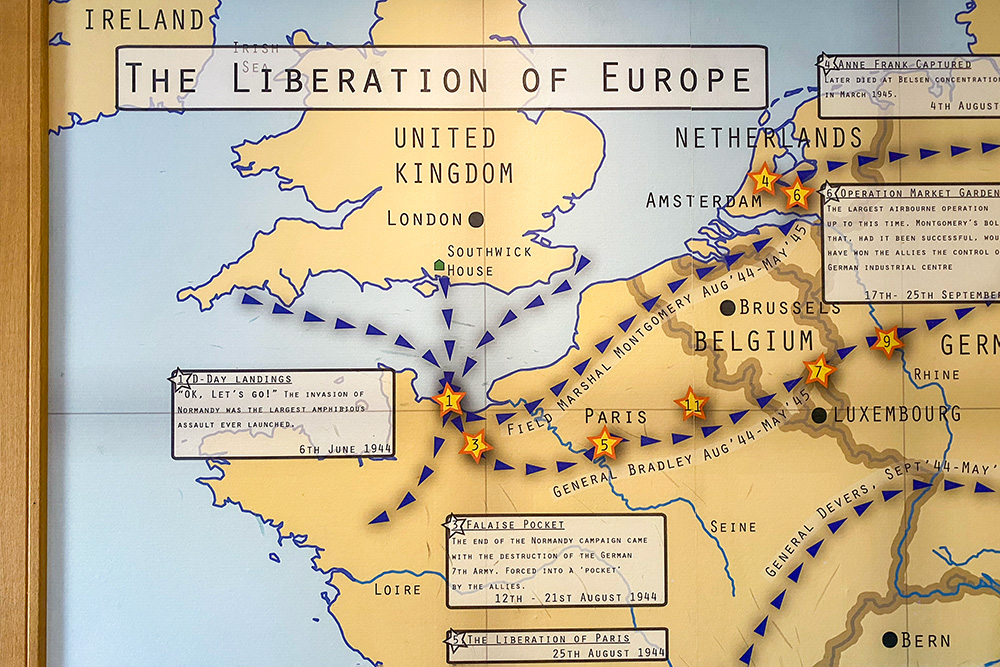
The Liberation of Europe from Southwick
Southwick Farm Barn
Opposite the Red Lion stands Southwick Farm Barn, a timber-framed barn whose beams have been dated to… 1494 – just two years after Christopher Columbus set foot in the New World!
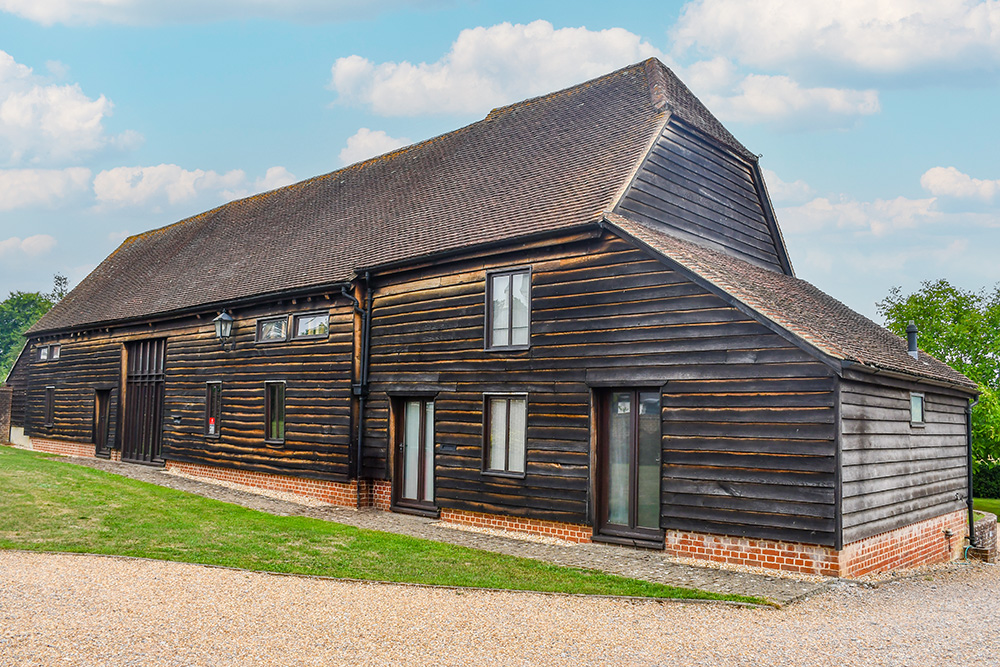
Southwick Farm Barn
Still standing more than five centuries later, it’s a reminder that Southwick is not just a witness to recent history, but a place that has endured through the ages.
Southwick House
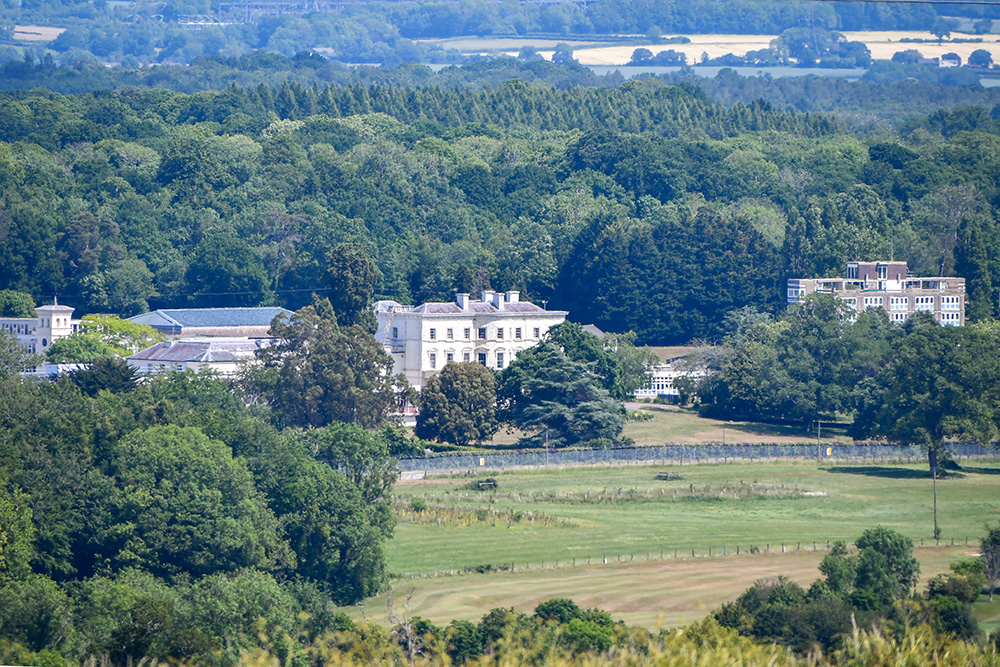
Southwick House seen from Portsdown Hill
This grand 19th-century Georgian mansion is famous worldwide for serving as D-Day Headquarters in 1944.
It was in the former library here that General Eisenhower gave the order to launch Operation Overlord.
Now occupied by the Ministry of Defence, the house isn’t open to the public on a regular basis, but occasional guided tours allow visitors to see the famous operations wall map.
Even from the outside, you can sense the weight of history in this place.
Practical Tips
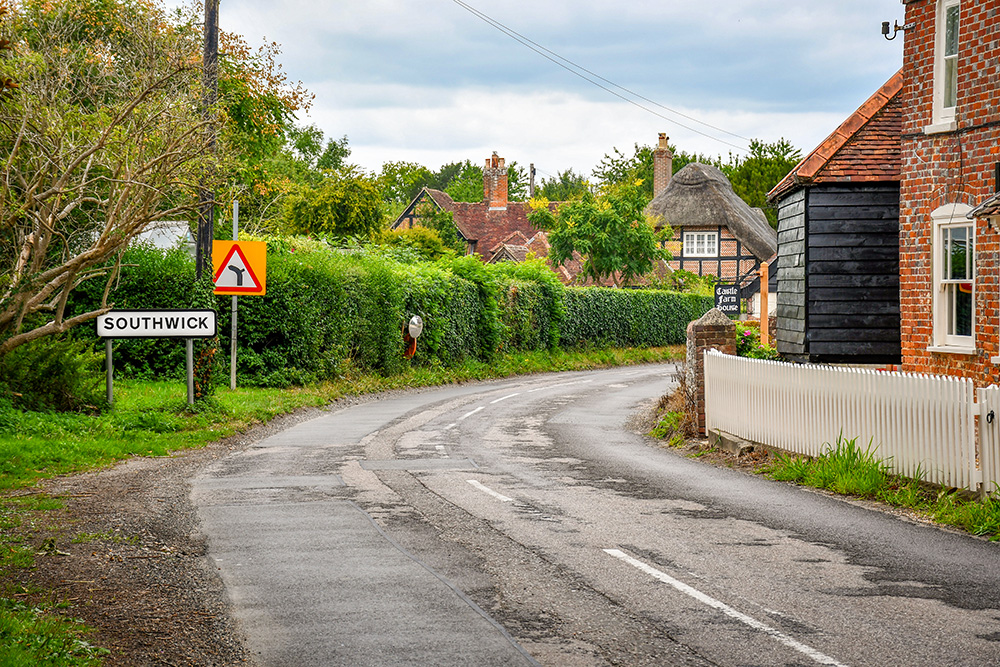
Arriving in Southwick from Denmead
- Getting there: Southwick is about a 15-minute drive from Portsmouth via the M27 (Fareham/Portchester exit), followed by country lanes. There is no railway station in the village, so driving is by far the easiest option. The nearest stations are in Fareham or Portsmouth, but from there you’ll need to take a taxi or a local bus – not the most convenient if you’re carrying luggage or in a hurry.
- Time needed: Allow just under an hour to explore the heart of the village – admire its red-doored cottages, visit the church, take a look at the priory wall, and perhaps stop at the tea rooms or a pub. If you plan to include the brewery or enjoy a full lunch, set aside half a day.
- Best time to visit: The village is pleasant year-round, but early June has a special atmosphere: it’s when the D-Day commemorations take place. Southwick comes alive with ceremonies, flags, and sometimes even period military vehicles in the streets. Do note that it gets much busier then, so it’s best to arrive early to enjoy the relative calm of the morning.
- A tip: Southwick is still a privately-owned village, and its residents value their peace and quiet. A gentle walk along the High Street, camera in hand, is the best way to capture its atmosphere – while respecting local life.
- To book accommodation in the area, explore the map below (Portsmouth and surroundings):
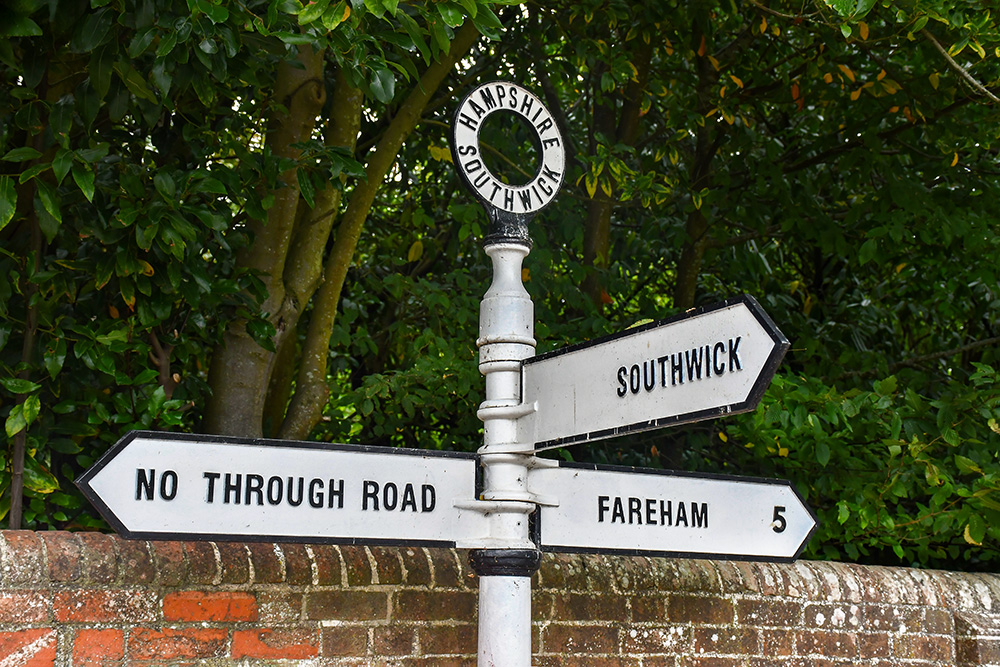
Southwick is this way!
Getting to Southwick
The village of Southwick is located in the Portsmouth area. Follow the B2177 towards Wickham.
- 10 km / 6 miles from Portsmouth Ferry Terminal – around a 16-minute drive
- 210 km / 130 miles from Folkestone (Eurotunnel Terminal) – around 2 hours 20 minutes by car
- 27 km / 17 miles from Southampton – around 35 minutes by car
- 120 km / 75 miles from central London – about 2 hours by car
Exploring Further: What to See Nearby
The best way to make the most of your trip is to stay in the Portsmouth area for a few days. That way, you can take your time and explore at a gentler pace.
Here are some highlights in the surrounding area:

